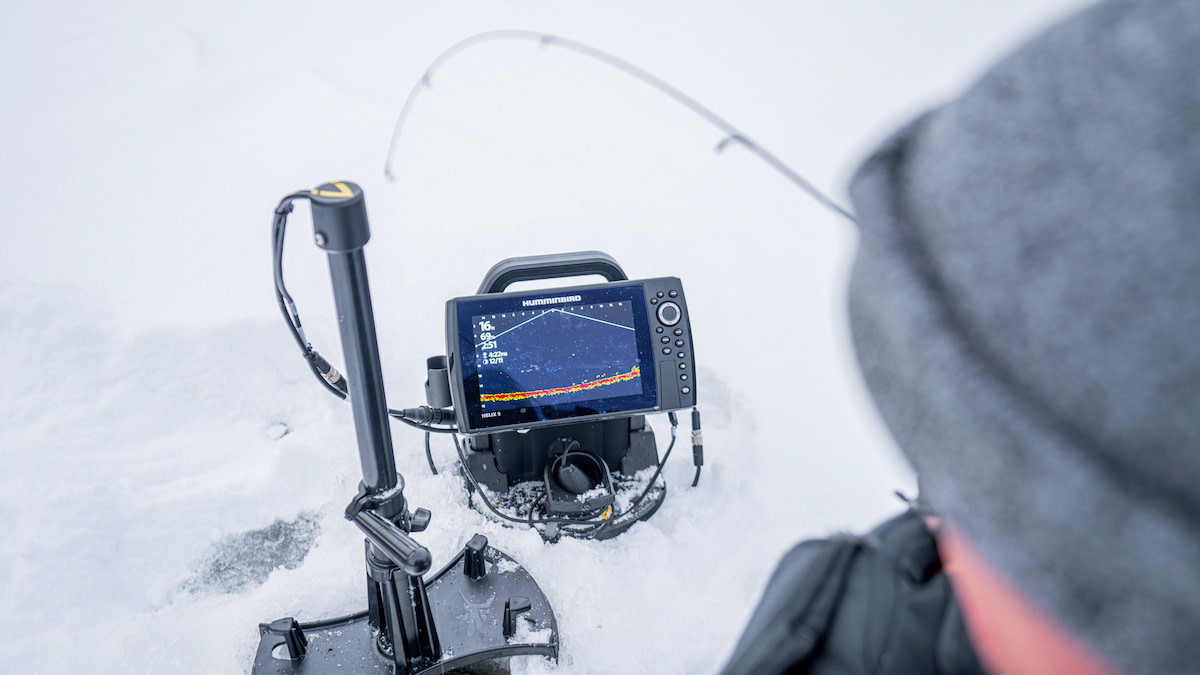
I’m generally old school and like to keep things simple. But the first time I used electronics for ice fishing, I knew I'd never fish without them. There are things you can fight, and then there are things you have to accept because they make a job so much easier you’d be crazy not to utilize them. Here are three trends in ice fishing technology that you should embrace this hard water season.
Live Sonar The first question many have is: What the heck is live sonar? Well, think of live sonar like real-time underwater radar. A sophisticated transducer sweeps to see fish as they move in the water column and displays that movement on your screen. Unlike a traditional flasher, live sonar is more three-dimensional than two-dimensional. The detail is so crisp at times that it's possible to see which way the fish is headed and even what species it is.
When you compare this to traditional sonar, which shows a fish in place inside the cone, it can be difficult to understand the fish’s size or exact location in the water column. On traditional sonar, as the fish moves closer below the transducer or farther towards the outside of the cone, it appears differently. This can make accurate two-dimensional sonar interpretation very difficult, especially when compared to live sonar like Humminbird’s Mega Live. This is because with live sonar you can actually see the fish swimming with enough detail to know which direction it's going and how it's moving in the water column.
It took me many years of ice fishing to learn on two-dimensional sonar that a fish that appears to be going back to bottom may actually be swimming in a circle away from your hole and not actually going down. Live sonar’s ability to immediately display how a fish reacts to your presentation can make a novice into a pro in short order. The same could be said for where and how many fish are actually in the water column around you.
Another huge advantage of live sonar is consistently seeing where the fish are going. While fishing large flats, staying on movements of fish like crappie or walleye can be daunting. With live sonar you can drill a hole and scan the area and work in the same direction the fish are moving, hoping to arrive where they do.
Underwater Cameras Fishing cameras have come about as far as the cameras in your smartphone. What once was black and white with poor resolution is now color and high definition. Depending on where you live and what you're fishing for, an underwater camera will mean different things for you.
I’m not afraid to say that I taught myself how to use a Jigging Rap-style bait by watching how the fish reacted to my movements via the camera. Species like walleye can be very camera-shy, however, so under such circumstances it's best to use the camera to learn the bottom type or the exact size of baitfish below. Think of it as recon. AquaVu just released a camera that has four separate lenses to literally give you a 360-degree viewing window. This might be just the advantage needed for walleyes on large flats. The camera can be dropped down another hole further away from your lure but you'll still see everything going on around you.
Other species such as panfish are hardly bothered by the lens. You can use a camera to find and watch pockets in the weeds and see a strike in real time. Last winter on a trip to Idaho for jumbo perch, we used a camera successfully to look for different bottom types that seemed to be holding the better fish. We also used it to determine what was covering our electronics screen. The constant marks we saw were actually giant schools of tiny 3- to 4-inch perch stacked on top of each other. While the advantage of a camera may change from day to day, there is no mistaking how valuable they can be.
More Power Sometimes we just want more power, but sometimes we need more power. The cold is hard on electrical items and they don’t last nearly as long under these circumstances. I think we all can relate to how our phone works afield in February as compared to June. It’s under these circumstances that lithium batteries have changed how we hunt and fish.
The advantages of lithium batteries don’t also carry a major downside aside from a larger upfront cost. Over time, the added battery life actually makes them less expensive. A battery that lasts twice as long is important, but it's equally as important that they weight half as much. This becomes a much bigger deal when you drag a sled through snow and slush and you feel every single pound.
The added power from lithium makes it possible to run GPS units with bigger screens and fish finders like the aforementioned Humminbird Mega Live. This weight savings also makes a huge difference when it comes to dragging around an auger. Electric augers like those from Ion drastically reduce weight and keep you from wondering if your auger will start every time you pick it up. The ability to drill enough holes to have a successful day without fear of running out of power is a big deal. The lack of oil and gas fumes also allows these units to be useful in confined spaces like your shanty or sleeper shack much more safely.
I know many of you will still swear by keeping it simple and not needing all this fancy gear, but I don’t see many of us rushing to use a spoon auger or phone booth anymore. Technology isn’t cheating, and the fish will still win plenty. Do what you can to put the odds in your favor.




